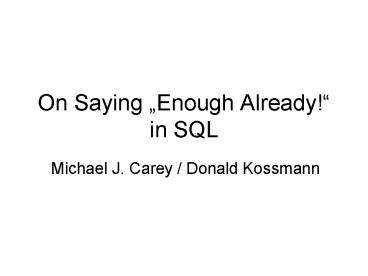On Saying Enough Already in SQL - PowerPoint PPT Presentation
1 / 6
Title:
On Saying Enough Already in SQL
Description:
Never insert a Stop operator at a point in a plan where its presence can cause ... STOP should reduce the cardinality of the tuple stream in proportion to the ... – PowerPoint PPT presentation
Number of Views:25
Avg rating:3.0/5.0
Title: On Saying Enough Already in SQL
1
On Saying Enough Already!in SQL
- Michael J. Carey / Donald Kossmann
2
Processing STOP AFTER Queries
- Scan-Stop
- outputs the first N tuples of its input stream
- cost estimate
assumptions
3
Processing STOP AFTER Queries
- Sort-Stop
- outputs the sorted N top or buttom tuples
- cost estimate
Cost of generating the whole input stream for the
Sort-Stop operator
Cost of testing (ALL-N) tuples against heaps
membership bounds
Cost of inserting i qualifying tuples into a heap
with at most N elements
assumption
4
Conservative STOP Placement
- Principle
Never insert a Stop operator at a point in a plan
where its presence can cause tuples to be
discarded that may be required to compose the
requested N tuples of the query result.
- Example
Stop(10)
SELECT FROM Emp e, Dept d WHERE e.works_in
d.dno AND d.function research ORDER BY
e.salary DESC STOP AFTER 10
Join
Dept
Stop(10)
Emp
5
Agressive STOP Placement
- Principle
Insert Stop operators in query plans wherever
they can provide a beneficial cardinality
reduction.
- Cardinality for Stop operator
STOP should reduce the cardinality of the tuple
stream in proportion to the optimizers estimate
of the overall cardinality
But How do we determine a new cardinality in
case of a restart?
paper predetermined factor (e.g. a factor of 2)
though their cost will be lower since much
of the relevant data will still be in the buffer
pool.
each one (of the restarts) requires
re-scanning the Emp table.
6
Discussion
- What makes a SQL Query cheaper when using
Stop-Statements
- Running time and optimality What is better, what
is still expensive
- How would a SQL query look like, if we wanted to
apply an algorithm we discussed before?
- Where in a query plan could we apply the FA, TA,
or MPro
- What is the papers contribution compared to the
papers we read before? What does the paper leave
out?














![[Latest Update] Microsoft DP-203 Actual Exam Practice Questions Shared Online PowerPoint PPT Presentation](https://s3.amazonaws.com/images.powershow.com/10142369.th0.jpg?_=20240928035)
















